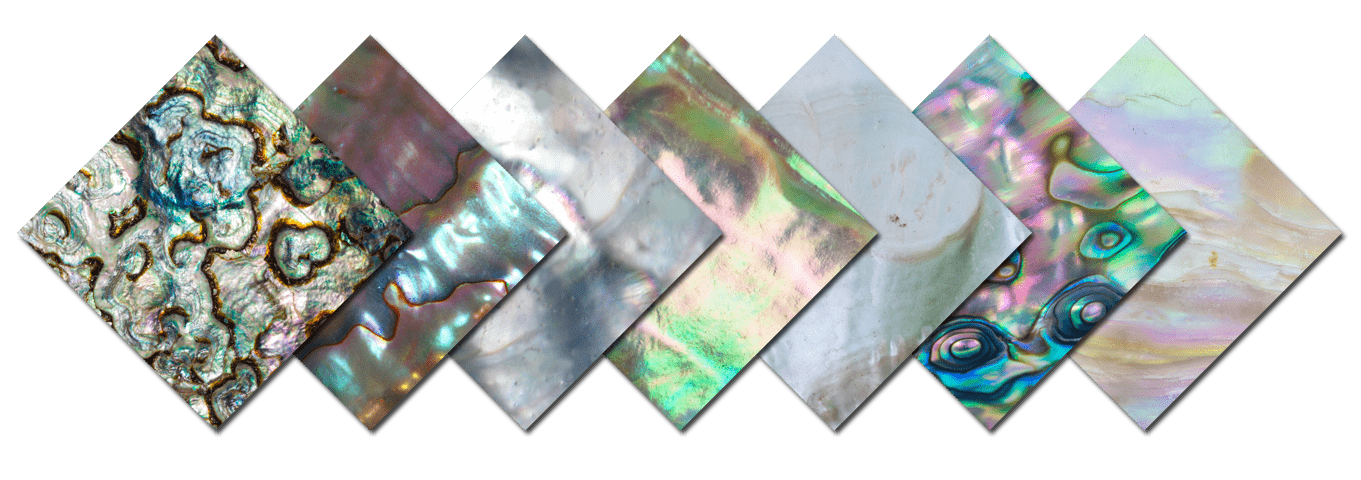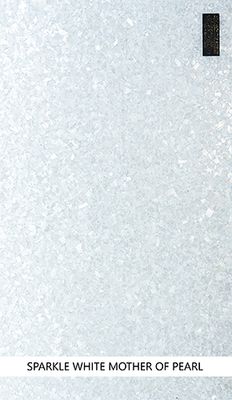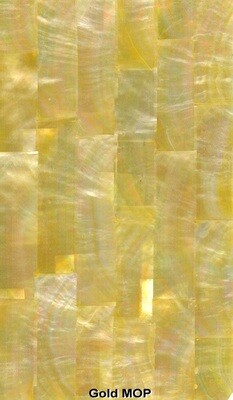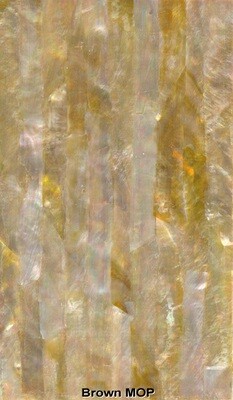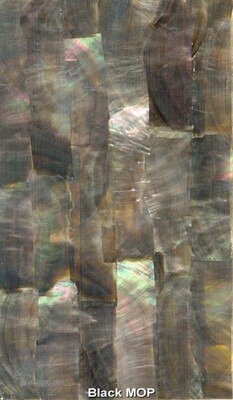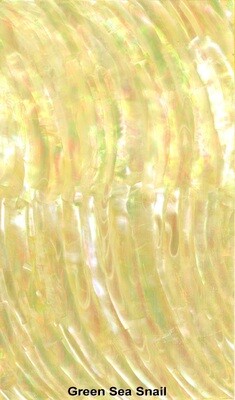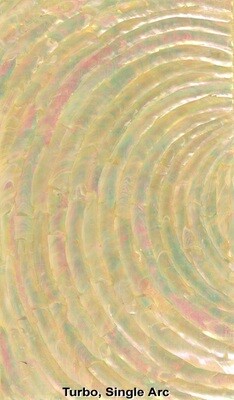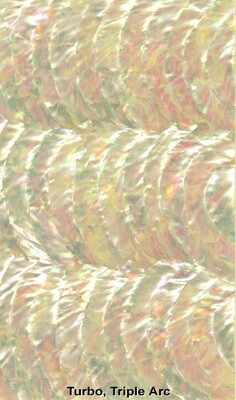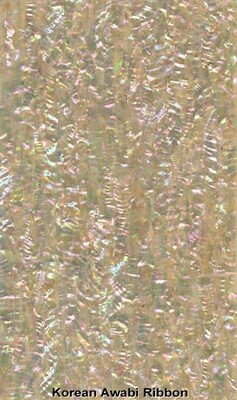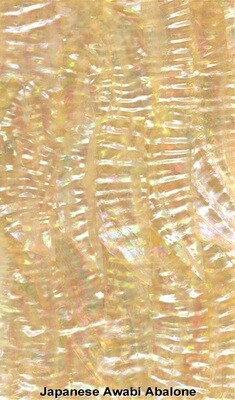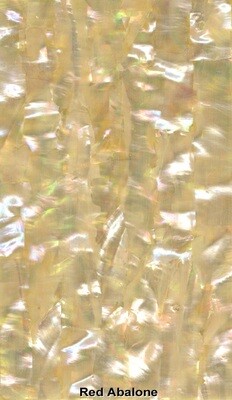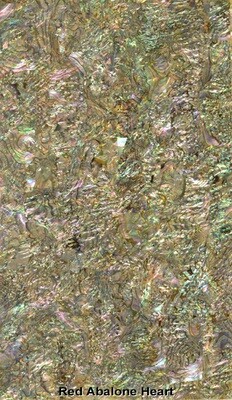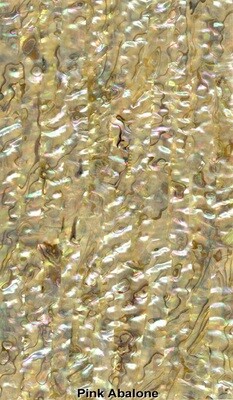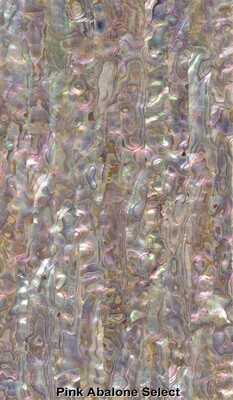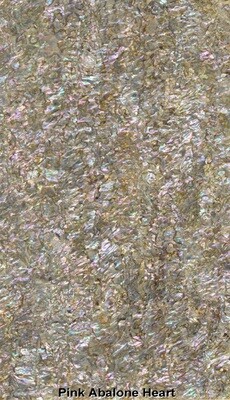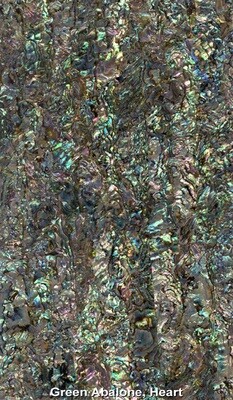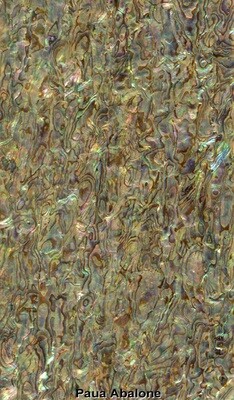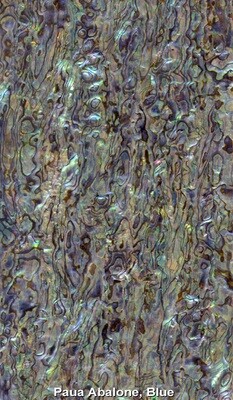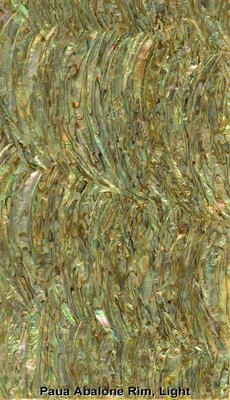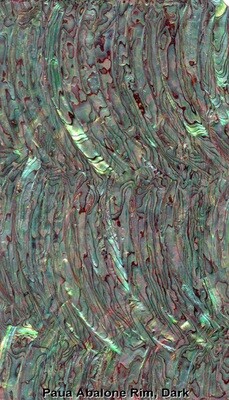.
ABALAM® LAMINATED SHEETS
Also sometimes misspelled as “ABLAM”. Developed jointly by the former Larry Sifel (founder of Pearl Works Ltd., in Mechanicsville, MD) and Chuck Erikson (His Pearlness, to you!), granted U.S. patents No. 5,776,581, No. 6,190,491, No. 6,432,506, and No. RE 40,207 E. Widely used by most guitar factories and smaller shops, this material has changed the way inlay is done!
These 5½” X 9½” (140 X 240mm) sheets are available in thicknesses from .030” (.76mm) to .250” (6.35mm), are made from real shell that has not been artificially colored or enhanced in any way, and most definitely are not to be confused with composite or reconstituted materials (except as noted for our “Sparkle” M.O.P. and abalone sheets). Each sheet is composed of thin layers of shell which have been stacked and bonded, each layer itself a mosaic of smaller pieces which have been color-matched and oriented to refract in the same way as found in the raw shell. The layers themselves have also been oriented and color-matched within each stack, so that the material will not change drastically when sanded down or shaped. Production of veneer plies is laborious, and dependent on the handwork of experienced and skilled traditional shell craftsmen.
We suggest leaving or trimming a 1/8” border around all four edges, to make sure that minor imperfections in this area do not interfere with finished parts. Also, all sheets have a label marking the TOP side, as reflectivity is best in this orientation, and the backside may contain one or several non-matching layers (in order to make best use of the highest grade shell in the top 2/3 of the sheet’s thickness, where it will be seen). To make top and back distinguishable on finished parts, we suggest using a soft lead pencil to mark the backs of sheets before parts are cut. If ink is used, it may run into surrounding material during glue-up steps.
The bonding agent used in sheets is a mix of several epoxies, which are resistant to acetone or finish solvents, but prolonged exposure/immersion might cause problems, especially with very delicate parts; soak or fume only long enough to release parts from the backer board (if using one), and do not leave overnight. For production cutting, the best method is to solidly super-glue the shell ply to a sheet of 1/8” tempered Masonite, cut the parts, cover the exposed shell surface with clear box tape, then drum-sand the Masonite off leaving all the parts stuck to the tape. This will keep all your parts same-side up and in perfect order, which makes storage and inventorying vastly easier than dealing with a loose jumble of parts mixed with scraps! Super-glues will not hurt sheets.
Veneer plies are about 10% less dense than the same shell in traditional blank form, and will cut best with a jeweler’s saw if you use blades a size or two smaller than you would normally use, perhaps down to a 4-0 or 5-0 size.
Ply sheets are NOT recommended for engraving, as they tend to chip or flake. If you must engrave, best results require first flooding the final shell surface with low viscosity (watery) super-glue to fill any small irregularities, lightly sanding back down to the shell, and then using a very well-sharpened graver to make multiple passes over each line until full depth is reached, using as little pressure as possible.
Some advantages over the traditional solid shell blank materials:
** Designs are not now limited by size or thickness requirements.
** Achieves more concentrated or intense coloration.
** Color is most of the way through, and will not carve or sand away.
** Less internal flaws, no hidden fractures, fewer rejected parts.
** Takes more or finer detail with less chance of breakage, especially if machine cutting.
** When used to make edge strips for guitars or furniture, strips will break to conform to curves more evenly with less pressure, breaking straight across instead of at odd angles.
** Very little waste compared with using blanks.
** Longer saw or cutter life, almost as though self-lubricating; allows faster feed speeds.
** Perfect match with modern computerized technology for production inlay cutting.
** Cost effective: at or below blank costs, especially considering waste factors/handling.
** Allows use of shell types not available before, or even development of totally new effects with existing shell by very selective use of specific areas of a shell.
** 400-600% higher yields from raw shell extends the life of increasingly hard-to-find resources, which also allows use of very expensive and super high-grade shells.
** Allows very large/long parts to be cut, reducing handling, labor, layout, and installation time. Examples: 3-pc. rosettes, 10-12 pc. guitar top trim sets, full fretboard vine in only 3 pcs., peghead edge trim in one U-shaped piece. Typical installation time for guitar top/rosette down from 1½-2 hrs. to an incredible 5-15 minutes!
Buy Shell Inlays & Sheets from the Duke of Pearl – Since 1967 we’ve been the world’s best source for top quality mother-of-pearl (“MOP”) and abalone shell materials used in stringed instrument inlay, reverse glass signage, furniture, marquetry, jewelry, and a wide variety of other crafts.
